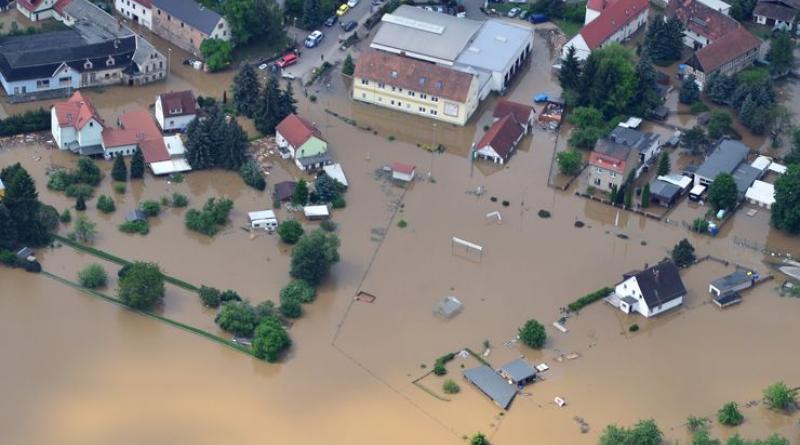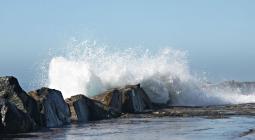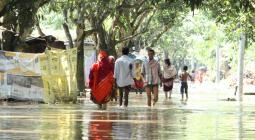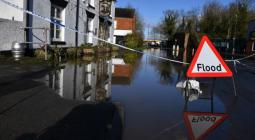How climate change may ‘flood’ global equities.

- We estimate that approximately 7% of global facilities operated by MSCI ACWI Index constituents are threatened by coastal flooding risk. Nearly 62% of index constituents had at least one facility in a flood-prone area.
- Regionally, Asia has the most coastal flooding exposure by far, with USD 2.25 trillion of revenue at risk between now and 2050.
- Without significant investment in coastal protection and adaptation, over half of covered global assets at risk could become untenable by midcentury.
Of all the threats to the environment from climate change, sea-level rise may be one of the most devastating and permanent.
Even if greenhouse gas (GHG) emissions are reduced in line with the 1.5 C temperature-rise stretch goal of the Paris Agreement climate accord, the global mean sea level may rise 0.29-0.59 meters by the end of the century, and may continue to rise into the following century.1
Even a modest increase in the global mean sea level of 11 centimeters could result in additional losses of USD 1.4 trillion per year (or 0.25% of global GDP), according to a recent study.2 The question for investors is how coastal-flooding risks may affect their portfolios. In this post, we examine the risks to global equity portfolios.
To estimate and attribute damage costs to company facilities, MSCI used probabilistic modeling and geographic information systems technology to project future flood damages under climate change. MSCI’s physical climate-risk analysis comprises approximately 221,000 geo-referenced assets from approximately 7,200 publicly listed companies. For each of these facilities, we assessed the threat of coastal flooding and the associated financial risks related to asset damage and business interruption. This analysis allows the model to determine cost profiles for each company and feeds into the calculation of MSCI’s Climate Value-at-Risk (Climate VaR) metric.
Gauging the depth of the problem
MSCI ESG Research estimates that approximately 7% of all facilities owned by covered MSCI ACWI Index constituents are under threat from coastal flooding.3 Further, nearly 62% of all index constituents had at least one facility in a flood-prone area — underscoring the importance of accounting for these risks and integrating that information into investment decision-making. Rising sea levels would likely exacerbate these risks.
Relative asset-damage risk to Asian company facilities
Asia had the highest exposure to coastal flooding risk by far, both in terms of the number of facilities and the level of potential damage at company sites. We identified 6,257 facilities at risk in Asia, with USD 2.25 trillion of revenue at risk4 between now and 2050. The EU had the second-highest number of facilities at risk from coastal flooding (2,270), while the U.S. had the second-highest amount of revenue at risk, at USD 541 billion. Without significant investment in coastal protection and adaptation, over half of the global assets at risk could become untenable by 2050, according to our model.5
No assurance of insurance
Should global action on climate change fail and extreme scenarios of sea-level rise occur as predicted by the IPCC, firms in the most exposed locations may experience more difficulty insuring assets, and without investment in flood protection measures, some companies could lose existing coverage.6 To identify the companies that are potentially more resilient to flood risk, investors may scrutinize which ones have more comprehensive insurance coverage as well as those that have put in place other risk-mitigation measures such as improved construction, upgraded floodwater drainage and retention capacity.
Institutional investors may want to review their options on how they work to protect their portfolios from physical-climate risks such as exposure to coastal flooding. For example, they may engage with companies on physical-climate risk, reduce their exposure within a sector and/or a portfolio or create climate-smart benchmarks. The one thing they cannot do about the potential risk is ignore it.
Read the full article on MSCI's website here.
1 IPCC. “Special Report on the Ocean and Cryosphere in a Changing Climate.” September 2019. This range refers to the projection of the global mean sea level under the RCP 2.6 scenario at the end to the century. 2 Jevrejeva, S. et al. 2018. “Flood damage costs under the sea level rise with warming of 1.5°C and 2°C.” Environmental Research Letters. 3 The Climate VaR model covers 2,344 out of 2,955 MSCI ACWI Index constituents (as of Dec. 31, 2019). Of those companies covered by the model, 144,014 locations can be evaluated. Coastal flooding risk can be found at 10,242 of these locations, meaning that 7% of the company locations in the ACWI would be exposed to coastal flooding risk under the RCP 8.5 “business as usual” scenario, unless further action is taken. 4 We define revenue at risk as the share of current company revenue attributable to facilities affected by specific extreme weather events or gradual climate shifts. To allocate revenue, we use the global breakdown by country and map country revenue to asset locations. 5 Assets deemed untenable will experience on average more than 5% of asset damage per year. 6 Mollod, G. and Robson, W. 2019. “Climate risk in private real estate portfolios: What’s the exposure?" MSCI Research Insight. 10 March 2020 ClimateAction





